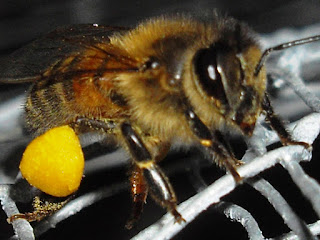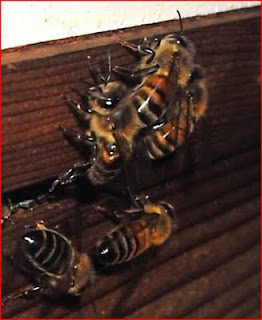I've been fuss-potting around for MONTHS planning my Next Significant Move with the bees. Yesterday my plan finally went into action.
I decided last summer that my bees are so successful, they need to go into a larger Brood Box. No longer a Standard British National, but rather a 14x12, which has deeper frames in the brood box to allow the Queen more space to lay and thereby reducing the likelihood of the colony swarming. Also, making the change from a standard-sized box to a larger box early in the season would focus the bees harder on the job of creating honeycomb in the new frames and thereby also decreasing their likelihood of swarming. (However, it is a notable saying of beeks that "bees don't read the same books that we do", so it's all a guess anyway.)
But also, because the bees now rule my heart and my head's gone out the window, a bigger box means less trauma every time I inspect the bees - instead of using a brood-and-a-half and breaking the 2 boxes and all the honeycomb every time I visit, the larger box and larger frames mean only 12 frames to inspect instead of 22.
All winter I bought new supplies - the larger brood box, the paint, the frames, the honeycomb. In the late winter, I spent several very satisfying evenings in front of the telly hammering nails into new frame constructions. Yesterday morning I put the final touches in place by adding the fresh wax foundation sheets.
And I also thought I'd try out a thing I'd seen on other hives - I spray-painted two squares on the front - one pink and one yellow. They say the bees' visual recognition of the shapes and colours aid them in geo-locating their hive entrance. Hmmmm, let's see, shall we?
We had a friend over for lunch yesterday and so it turned out I had an audience to further intimidate me on this all-important manipulation. I was filled with trepidation, in addition to aching all over from a two-hour bike ride the previous day.
No doubt about it, I was nervous all round.
It took a lot of persuading to get My Guy suited up in a beesuit too; he sounded like a very reluctant Tigger and had all sorts of reasons why he couldn't possibly help me move the hive. But eventually - valiantly - he donned the suit and stepped forward to help. I needed to move the double brood box, roof and floor 2 feet to the left and move the entrance 90 degrees off from the original, to confuse the bees.
"Put your hands under here," I said "and commit yourself. Just pick it up and step back smoothly" and that said, I proceeded to tangle myself in a loose piece of barbed wire and stagger all over the place, nearly toppling the hive and scotching all our plans. The audience (standing a goodly 6 feet away) fell about laughing. Not a good start ...
Finally the two of us were set; we lifted the hive (setting off an alarmed BUZZZ from within) and set it down nearby.
That's when I suddenly realised It Was All Finally Happening.
I spent so much time visualising practice runs in my head, all winter. Funnily enough, all of my thoughts had sort of meandered off into mingled dreams of success and holidays in New Zealand, so I hadn't really visualised the entire process through from beginning to end.
A lot also counted on me finding the Queen. Which, of course, I didn't.
She was nowhere to be seen so I just plodded on regardless. I placed the new Pink & Yellow Hive in the original location, onto the lovely heavy hive stand gifted to me by my mentors. I made sure lots of deep frames were standing by, then took a deep breath and opened the Itchy Knee/San-Shi double brood hive.
They were lovely; I'll grant them that - the girls were incredibly forgiving and never stung me once (that I know of. I was suitably layered in about 6 shirts and 3 pants, and sweating like a pig before 5 minutes had lapsed.) I began by identifying, in Itchy Knee, which frames had brood and transferring those. I bumped all the bees gently off their frames into the new hive.
I set that box aside, covered it gently, and began to look through the previously-unchecked San-Shi hive. There were 4 frames of brood, including capped Drone cells. She is well on her way for the Summer, that's for sure!
My silly bleeding heart couldn't cope with the thought of killing too many babies, so I transferred 7 frames full in all. I know that's going to cause trouble later on, I just know it:
- Those original shallower frames will encourage the bees to build wild comb underneath, which they'll join up to the floor - bad when I inspect and have to pull them out :(
- At some stage, I'm going to have to replace them anyway with new, deeper frames. I've just prolonged the inevitable. I am silly.
But - oh well - what's done is done.
At no stage did I see the Queen. I am a bit worried about that, but perhaps less than I should be because, bless them, the bees went across quietly, and they all immediately gathered through the new hive entrance. Plus I know that if I've lost her, they have enough baby brood to begin building Emergency Queen Cells to replace her.
I know too how resilient these bees are; they are doing so well already and they have survived so much, so far, I know they are good.
Once again, they inspire me. It was satisfying to hear the audience suitably "oohing" and "aahing" through the course of the manipulation; My Guy said afterwards "you looked really confident and professional all the way through, Margs, more than ever."
* * *
I went straight in from the hive, stripped off a couple of sweated-through layers and sat down to lunch with Guy and friend. A glass of red wine gulped back with the magnificent meal - it all tasted wondrous. Endorphins enhancing the high, I'm guessing :)
Much later that evening, in the blue glow of twilight, I went back down to the apiary to check on the girls. The old boxes were clear of bees and I removed all the honey frames to the Kitchen lean-to room (hereforward to be known as The Beekeeper's Room) - first honey to process! It was fascinating to see that one entire frame - front and back - was glued solid with a black concrete-like honey. Ivy; the first I've ever seen; honey that granulates and solidifies so fast in the honeycomb that it's useless to the bees, who can't extract it in the winter and often starve to death in a hive filled with the stuff. Most interesting to see, and I wonder if it's still possible for me to extract and taste ... must investigate further!
The bees were still; a few circling in the air above, and dozens crawling all over the white exterior and marching in lines around the Pink and Yellow Squares. I do hope the fresh paint smell doesn't put them off. I fed them, and will feed them again in 48 hours. The sugar water stimulates their wax production glands, and they will be drawing out honeycomb furiously fast. I can't wait to see it!
* * *
I miss being close to my old beek association, and am looking forward keenly to seeing them all again in mid-April at the Secret Bee Hut. Never better than when a whole load of beeks stump into the old hut together and jabber away at top volume,"like a bunch of High Country farmers," says Guy "who've been alone all winter and can't wait to catch up on each other's lives!" :)
Too right, mate!













